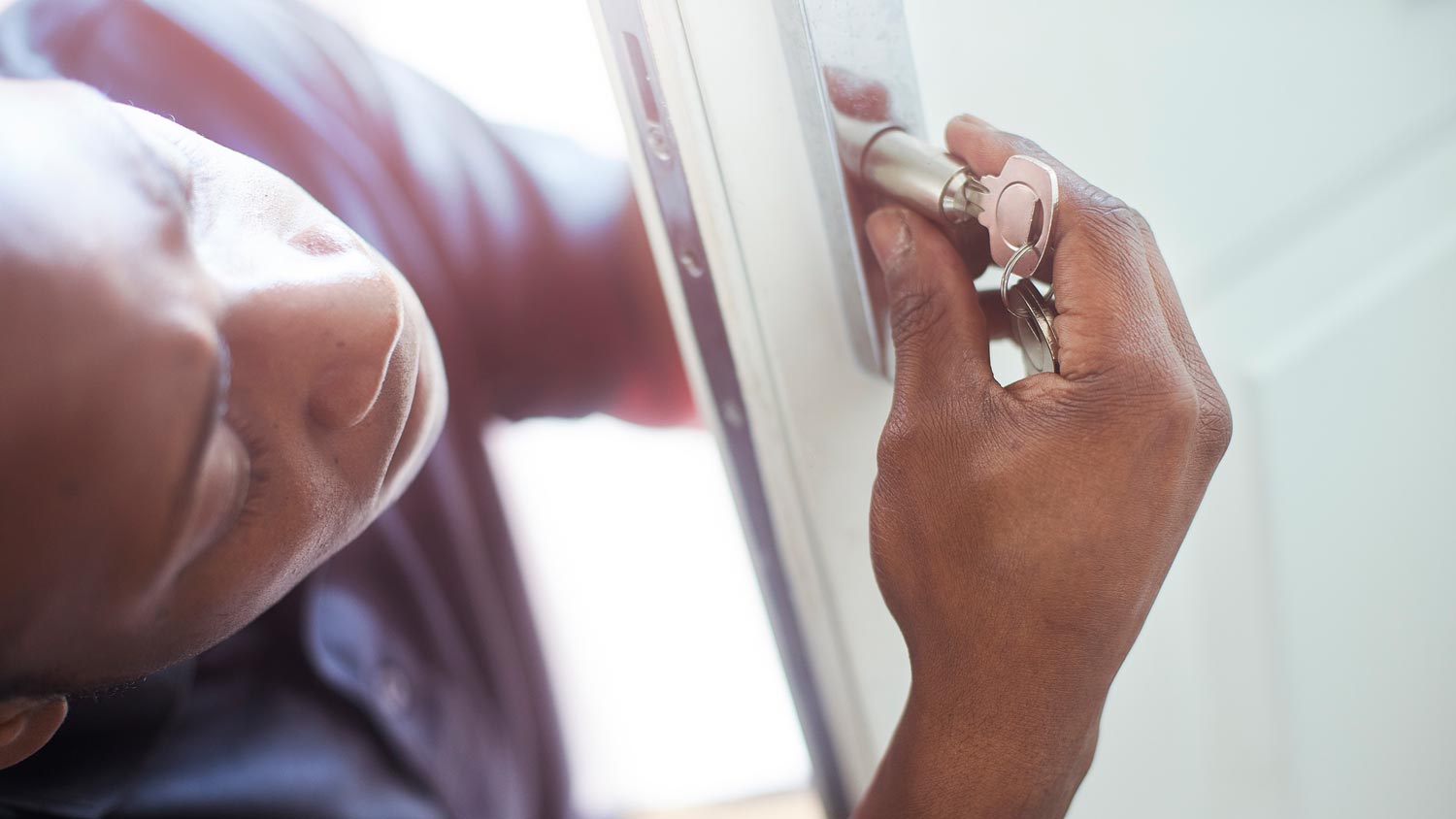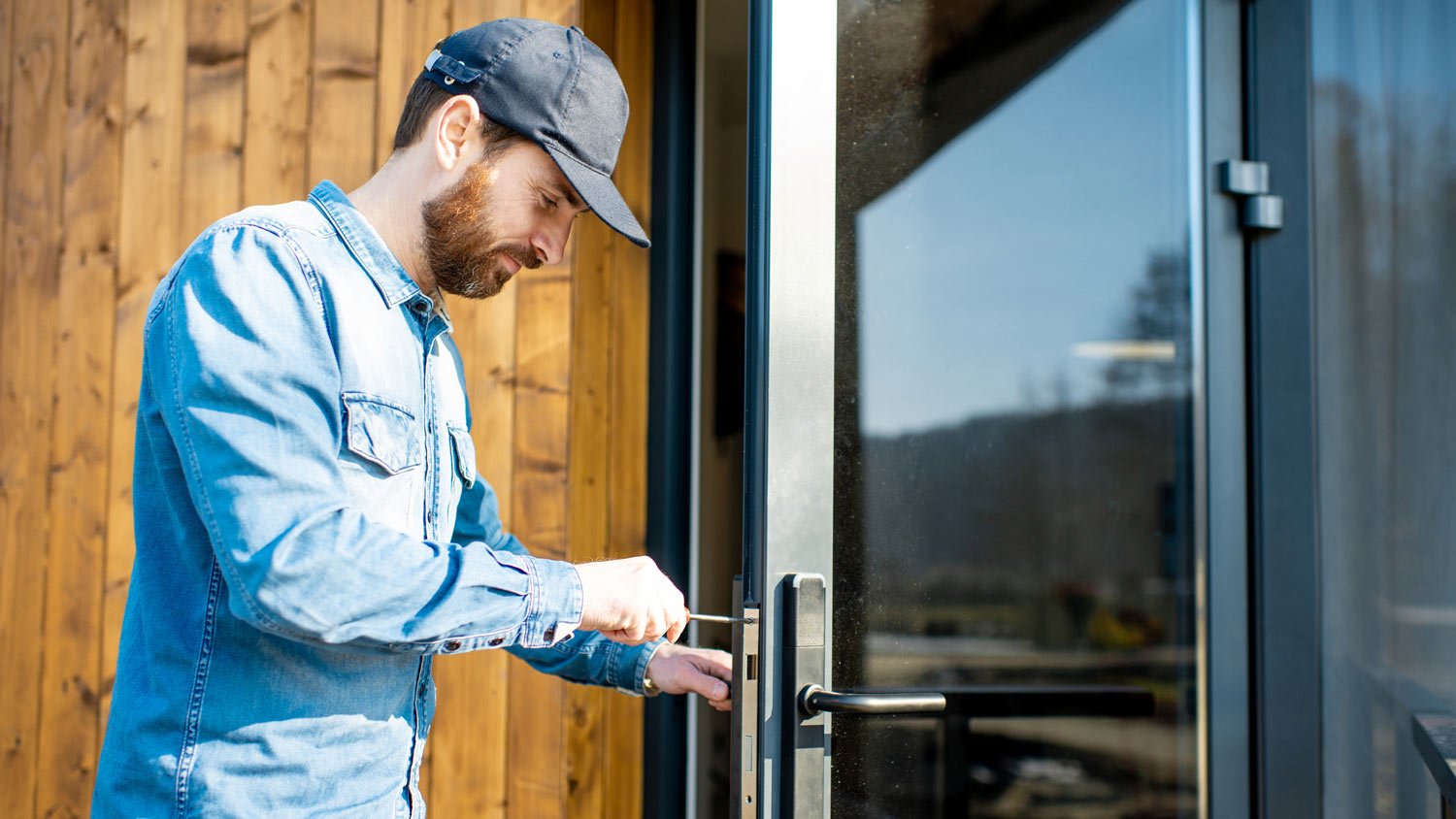How to Rekey a Lock in 11 Steps
Unlock a new skill with this DIY project


Whether you lost your keys (again) or just moved into your dream home, rekeying your locks is a smart decision. It’ll give you added peace of mind and help you learn a new skill at the same time.
While you can always choose to hire a locksmith instead, this DIY is a fairly straightforward project. Learn how to rekey a door lock below, and what to do if it’s a deadbolt or smart lock.
How Locks Works
Before you start the process of rekeying a lock, it's useful to know how a traditional door lock works. Most door knobs and deadbolts feature a pin and tumbler lock.
The lock contains a steel cutaway that holds a cylindrical plug and several springs and pins that allow a uniquely cut key shape to turn it. For the lock to work, the length of the pins must match the depth of the unique grooves in the key.
To rekey locks using a different existing key, you would dismantle the lock and the pins, which vary in length. Then, you would remove and place the pins to match and fit the new key you wish to use for that lock.
How to Rekey a Lock

You can complete the process of rekeying a traditional pin and tumbler lock in as little as 11 steps. The project could take one day out of your weekend, but you’ll still have plenty of time to relax with friends and family in your security-enhanced home when you’re done.
1. Purchase a Rekeying Kit
To rekey locks, you need to purchase a rekeying kit that is specific to your brand of door knob or deadbolt. If you have varying brands, you don't need to worry about ending up with different keys. You can use the same key for each regardless of brand.
The rekeying kit comes with everything you need to complete this task, such as tiny picks and tweezers, a key gauge, an assortment of pins and springs, and any other tools you’ll need to disassemble and reassemble the lock.
2. Remove the Door Knob
This step will vary by maker, but you can expect to align the holes in the cylinder and then either insert the key and turn it a quarter-turn to the right or turn the knob counterclockwise. Then, using the remover tool that comes with the rekeying kit, you'll remove the door knob from the shank.
3. Remove the Cylinder Lock
Next, you'll remove the cylinder from inside the knob by pushing the cylinder back.
4. Remove the Clip Ring
The cylinder has a C-shaped clip holding it in place. Remove the C-shaped clip using the tool provided in your rekeying kit.
5. Remove the Key Plug
Using the follower tube supplied in the rekeying kit, remove the key plug from its housing. The follower tube will stay in place as you remove the key plug, so the pins and springs don't pop out prematurely.
6. Remove the Old Pins
This step is best done on a flat, clean surface. Drop the old pins from the plug and place them to the side to avoid mixing the new pins with the old pins. Remove the old key and insert the new key.
7. Insert the New Pins
Following the instructions with the rekeying kit and using the included tweezers, insert the new pins, ensuring they are flush against the plug.
8. Reinsert the Plug
Place the plug back into the cylinder, which will slowly push the follower tube as you insert it. Remove the follower tube completely and test to ensure the key turns.
9. Reattach the Clip Ring
Replace the C-clip using the provided tool until it snaps into place.
10. Reattach the Knob to the Door
Reinsert the cylinder into the knob. Attach the knob to the door.
11. Test the Lock
Ensure the knob feels secure and then test to confirm the new key works.
Rekeying Deadbolt Locks
What about other types of door locks, such as deadbolt locks? The steps for rekeying a deadbolt lock are similar to a traditional pin and tumbler lock. If the brand of lock is the same as the door knob, you can use the same rekeying kit. However, if they are different brands, you'll need to purchase the correct rekeying kit.
Remove the deadbolt from the door and repin the same way you would a door knob.
Ensure the bolt is out before removing the screws holding the deadbolt to the door.
Remove the cylinder and then the endcap before taking out the retainer pin.
Follow the same steps for repinning a door knob.
Then, replace the cylinder, retainer pin, and endcap before returning it to the housing. Double-check that the bolt is out and then reattach the lock to the door.
If your home currently doesn't have deadbolts, consider installing a deadbolt to increase home protection. To keep all the keys for your locks the same, opt for the same brand of deadbolt as your doorknobs.
Rekeying Smart Locks
Whether or not it's possible to rekey a smart lock varies based on the type of smart lock and the brand. Some smart locks don’t use keys, while others come with a physical backup key, which replaces or fits over an existing door lock. If you have a smart lock and are considering rekeying, it's best to determine the steps specific to the brand of your lock.
When to Rekey a Lock vs. Replace a Lock
In some cases, simply rekeying a lock isn’t enough; instead, you’ll need to replace the lock entirely. Luckily, the person you call to replace the lock is the same person you’d call to rekey it (if you’re not DIYing it), so the pro can help you make the right decision if you’re not sure.
But if you are DIYing, here are some things to consider on your own when determining whether you should rekey or replace a lock. (Spoiler alert: The cost to change door locks is more expensive than the cost to rekey them, especially if you have to hire a pro.)
When to Rekey Your Door Locks
Changing housemates: If a roommate moves out, you separate from a spouse or partner, or someone who was temporarily crashing on your couch finds a permanent spot to live, you’ll want to rekey your locks. While they’ll likely return the key, you never know if they made copies; you can’t be too safe. Similarly, if someone who used to require access to your home no longer needs it—like a pet sitter or a former friend—and doesn’t return your key, it’s wise to rekey the lock.
Lost key: If you’ve lost a key, or your key was stolen, you want to ensure that the key can no longer be used to enter your home. As long as you have another copy of that key, you can successfully rekey the lock. (You need a copy of the current key to rekey a lock.)
A single key: Homes with multiple entry points—front doors, back doors, garage doors, basement doors, etc.—may have multiple locks, meaning you have to carry multiple keys on your keychain (and remember which key goes to which lock). You can simplify this by rekeying all the locks to match a single key.
When to Replace Your Door Locks
Lost key: If you’ve lost a key, or your key was stolen, and you don’t have another copy of the key, you won’t be able to rekey it. Instead, you’ll need to hire a locksmith to replace the lock outright and provide you with a new key.
Style update: Changing the type of lock or type of door knob or handle usually means you’ll replace the lock and get a new key.
Damaged lock: And, of course, if a lock is damaged, you’ll need to hire a locksmith to remove the broken lock and install a new one.
Tips for Rekeying Door Locks

If you are rekeying your entire house, you can simplify the process by rekeying the locks all at once. Just keep all the pins separated so each set stays with the original lock.
The rekeying process involves handling tiny pins. Avoid taking on this task with small children or pets nearby. If you are a person with vision impairment, consider using a magnifying glass to help with the process.
Before throwing away your old keys, ensure the new ones work properly.
DIY vs. Hiring a Pro to Rekey a Lock
Rekeying a lock is a straightforward DIY task many homeowners can tackle. However, if you don’t have steady hands or you have poor vision, consider hiring a pro. The task can also be time-consuming if you’re not familiar with the work; what takes a pro 15 minutes might take you a couple of hours. If you’d like a fast process, consider calling in a pro.
If you need to replace a lock, rather than rekey it, it makes more sense to hire a local locksmith.
Frequently Asked Questions
Rekeying door locks yourself costs a fraction of what you would expect to pay a locksmith. On average, it costs between $50 to $100 to hire a local locksmith to rekey your house, though labor costs may vary based on where you live. For a DIY solution, you can expect to spend $11 to $25 on a rekeying kit.
Typically, it can take around 15 minutes to rekey a lock. The time depends on the type of lock and how skilled you are at rekeying. The first time you rekey a lock, it may take a little longer. Once you get the hang of the process, it will move along much more quickly.
Yes, even if you are the first owner of a home, it's a good idea to rekey your locks. During the construction and selling process, there have been several people in and out of the home. Your safest option is to rekey all locks.





- How to Get a Broken Key Out of a Lock (With Tools You Already Have)
- 8 Types of Deadbolts: Which Is Best for Your Door?
- How to Secure a Door Without a Lock While You Wait for a Locksmith
- Are Keyless Door Locks Safe? Pros and Cons of Keypad Locks
- Should You Buy a Smart Lock or a Regular Lock
- 11 Handy Tips and Tricks to Help With Your Next Home Project
- Why Water is Leaking Through Your Sliding Glass Door and How to Stop It
- How to Fix a Door That Sticks: 5 Different Methods
- 9 Tips to Make Installing a Pocket Door in Your Home Easy
- Parts of a Dishwasher: Learn What They Are and How They Work










